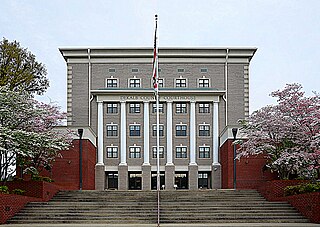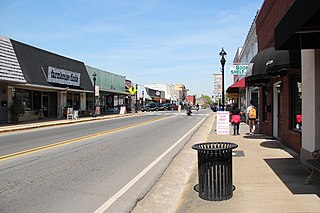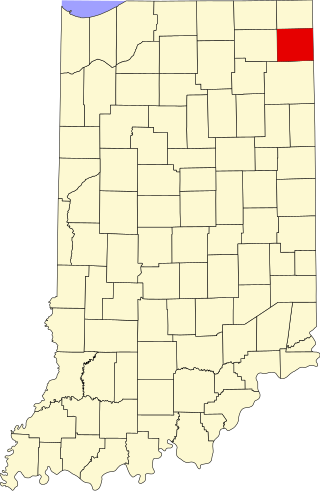
DeKalb County is a county in the northeastern part of the U.S. state of Alabama. As of the 2020 census, the population was 71,608. Its county seat is Fort Payne, and it is named after Major General Baron Johann de Kalb. DeKalb County is part of the Huntsville-Decatur-Albertville, AL Combined Statistical Area.

Fort Payne is a city in and county seat of DeKalb County, in northeastern Alabama, United States. It is near Lookout Mountain. At the 2020 census, the population was 14,877.
Willstown was an important Cherokee town of the late 18th and early 19th century, located in the southwesternmost part of the Cherokee Nation, in what is now DeKalb County, Alabama. It was near Lookout or Little Wills Creek. It was in Wills Valley, which also incorporated Big Wills Creek. This was within the territory of the Lower Creek, who had crossed into this area in an effort to avoid European-American encroachment.
This is a list of the more than 2,000 properties and historic districts in the U.S. state of Georgia that are listed on the National Register of Historic Places. Listings are distributed across all of Georgia's 159 counties. Listings for the city of Atlanta are primarily in Fulton County's list but spill over into DeKalb County's list.

This is a list of the National Register of Historic Places listings in DeKalb County, Alabama.
Paynes Creek Historic State Park is a Florida State Park located on Lake Branch Road one-half mile southeast of Bowling Green, Florida. On November 21, 1978, it was added to the United States National Register of Historic Places, under the title of Payne's Creek Massacre-Fort Chokonikla Site.

The Grand Opera House is an opera house located at the corner of 8th and Iowa Streets in Dubuque, Iowa that was built in 1890. It was listed on the National Register of Historic Places in 2002.

The Saenger Theatre, also known as the Saenger Theater, is a historic theater in Pensacola, Florida. It is located at 118 South Palafox Place. On July 19, 1976, it was added to the U.S. National Register of Historic Places.

The Cotaco Opera House, also known as Masonic Building, was the first opera house constructed in the state of Alabama. It is located at 115 Johnston Street in historic downtown Decatur, Alabama.
Winnona Park is a historic area in the southeast corner of the Atlanta, Georgia suburb of Decatur. It is listed as a historic district on the National Register of Historic Places, but it is not one of the City of Decatur's locally designated historic districts.

This is a list of the National Register of Historic Places listings in Allen County, Indiana.

This is a list of the National Register of Historic Places listings in DeKalb County, Indiana.
Bootsville is a ghost town in the Sand Valley area of central DeKalb County, Alabama, United States. It was located roughly five miles west-southwest of Fort Payne, placing it near the present-day intersection of County Road 458 and County Road 461.
Cherokee Plantation may refer to:
Cochran House or Cochran Farm or Cochran Barn may refer to:
Manitou Cave is a cave in Alabama, near the town of Fort Payne, in the side of Lookout Mountain. In the early 1800s, the Fort Payne area was a Cherokee settlement named Willstown. This was the home of Sequoyah during his time of creating the Cherokee syllabary. Later, Sequoyah's son wrote on the walls of Manitou Cave using this syllabary, documenting ceremonial events and other culturally significant information and history. In the 1830s, Cherokee people were forcibly relocated from this area along the Trail of Tears, leaving the cave empty for some time. During the Civil War, the cave was a source of saltpeter for the Confederate Army. The mineral was mined by laborers to provide the essential ingredient for black powder. The cave was also designated fallout shelter during the Cold War.

Cherokee Plantation is a historic house in Fort Payne, Alabama, United States. The house was built in 1790 as a two-story log cabin by Andrew Ross, a judge on the Cherokee Supreme Court and brother of Principal Chief John Ross. In 1834 a second log cabin was built connected to the rear of the original cabin, and a third was built to the northeast, separated by a breezeway. Ross, being one-eighth Cherokee, was forced to leave his home in 1838 under the provisions of the Treaty of New Echota, of which Ross was a signatory; a portion of the Cherokee Trail of Tears passes in front of the house.

The Fort Payne Boom Town Historic District is a historic district in Fort Payne, Alabama, United States. The district encompasses five properties built around 1889, when Fort Payne was undergoing huge growth owing to the area's mineral deposits. Included are the Alabama Great Southern Depot; the Fort Payne Opera House; the Sawyer Building, a two-story Victorian commercial building; City Park, which sat across from the (now-demolished) county courthouse; and Purdy Furniture, which built as the headquarters of the Fort Payne Coal and Iron Company. Another Victorian commercial building has since been demolished. The district was listed on the National Register of Historic Places in 1989.

The Fort Payne Main Street Historic District is a historic district in Fort Payne, Alabama, United States. Centered on the intersection of Gault Avenue and 1st Street, the district contains commercial and public buildings that date from Fort Payne's second period of growth from the 1920s to World War II. Buildings from the first wave of development in the 1880s and 1890s are centered in the Fort Payne Boom Town Historic District to the northeast. Most of the commercial buildings are in a simple, utilitarian brick style. The later civic buildings exhibit more decorated styles, including the Classical Revival Post Office, and the Art Moderne City Hall (1941) and DeKalb County Activities Building (1941). The district was listed on the National Register of Historic Places in 1989.

The Mary Gay House is a historic house at 716 West Trinity Place in downtown Decatur, Georgia. It was the home of Mary Ann Harris Gay, who moved there with her mother and sister about 1850. She and her sister lived there during the American Civil War and afterwards. The house was built approximately 1850 and is one of the few extant pre-Civil War buildings in the area. The house was entered into the National Register of Historic Places (NRHP) on May 6, 1975. It is now named "716 West" and is used as a wedding/event venue.














